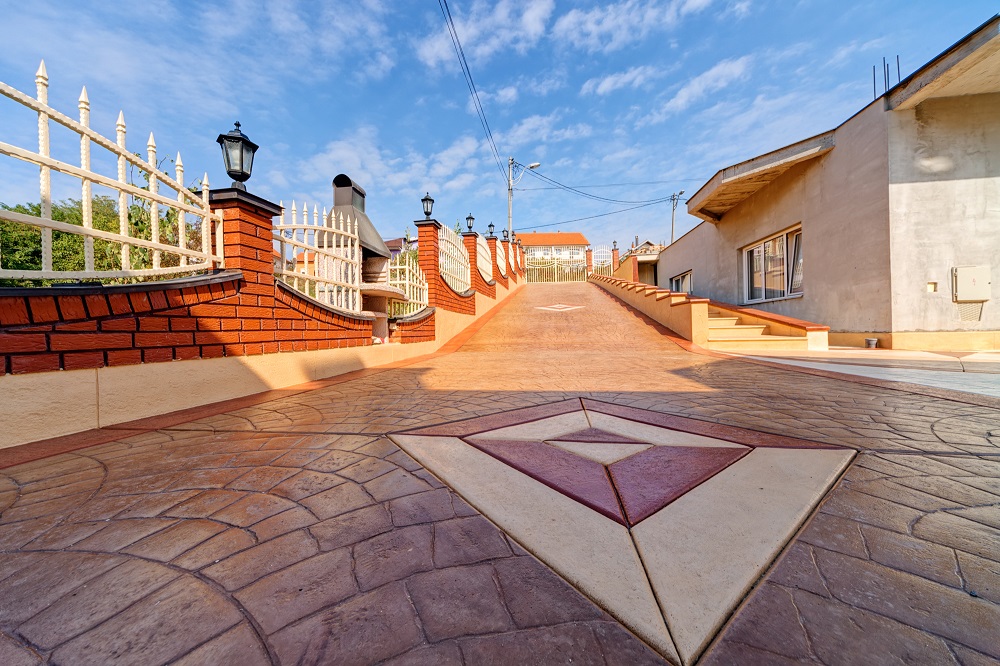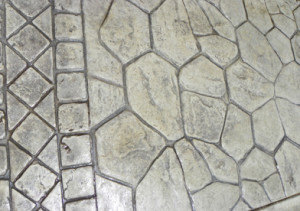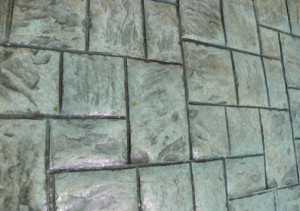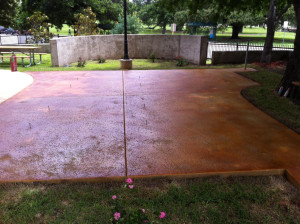
Many people think of a decorative concrete contractor as just another professional that needs to be scheduled to perform a job. Usually people want to spend as little as possible when hiring a decorative concrete contractor. However, installing this type of artistic concrete should not be taken lightly, as it’s a delicate process, and this is why planning for the construction component is so important.
In the past, decorative concrete didn’t come in many finishes, but today there are many finishes available, and some of these include textured, stamped and integral. Other finishes that the concrete is available in include coatings, diamond polish, stampable overlays, acid etch and dust-on. Self-level overlays, stencil, form liners, exposed aggregate and sandblast are other options available, and let’s not forget to mentioned that finishes can be combined with other types of finishes.
Here are a few examples of artistic finishes we offer for decorative concrete projects:



The 5 Most Important Considerations for Decorative Concrete Projects
The creative possibilities are virtually endless, and is usually only limited to the contractor’s imagination, and creativity is one of the reasons why many people use decorative concrete. However, concrete is sensitive to many variables. This means the final outcome can be impacted in either a positive way or a negative way. So, for your next decorative concrete project focus on these 5 things for success.
1. Asses Client’s Expectations
The owner should provide a description of what the finished work should look like. This allows the contractor to figure out if it is possible and estimate the cost. A lot of people tend to have expectations that are not reasonable, and this is why it is best to discuss expectations as soon as possible.
Concrete that is decorative tends to not be structural, but sometimes people write specifications that make them look like it. A good example of this is if someone specifies that the concrete should be high compressive or flexural strengths. A contractor should focus on the decorative requirements primarily, because the structural requirements may be met, but the aesthetic requirements may not meet expectations.
2. Choose The Right Contractor
Some decorative concrete contractors are more creative than others, and if you want creative work, then you need to find someone who has good crafting skills and one that can perform at the level you want them to perform at. You will need to do a bit of research to narrow down your choices because contractors tend to focus on one aspect of decorative concrete. Also, you might want to consider hiring a concrete contractor that provides place-and-finish, because some contractors don’t place-and-finish concrete, as some don’t know how to do it.
3. Schedule The Work In A Way That Avoids Damage To The Concrete
What this means is that you want to carefully schedule the installation of concrete with other trades in mind, because you don’t want the concrete slabs to become damaged before the decorative work starts or even afterwards. Plumbers have been known to do things such as spill liquids that stain on slabs, as well as spill hot solder and glue on the slabs. Some carpenters have been known for placing their belongings on it or stacks of lumber, and many trader workers can leave footprints on the slabs of concrete.
The key is to avoid unnecessary conflict. The way to do this is to have the work done on the weekend or start it on Friday afternoon and work through the weekend. This will reduce the chances of the concrete slab from becoming damaged as a result of other trade workers’ actions.
4. The Finished Work Needs To Have The Right Protection
A lot of people think that concrete becomes stronger over a period of time, and then there is nothing left to do with it, but this isn’t the case at all. Concrete ages, and as it ages it becomes vulnerable due to chemistry changes, and water on the surface of the concrete can cause chemical changes and physical changes. It is extremely important that the finished work is protected, and this should be discussed before construction even begins.
Vapor from the concrete needs to be able to pass through, while not allowing products that stain to come in contact with the concrete’s surface, and this is exactly what covering material must allow. A concrete contractor is not going to wait around for the concrete to be cured, and this means the general contractor needs to protect the decorative work, but the subcontractor still has some responsibility. The subcontractor should be able to tell the general contractor what products they should use to protect the work, and they may be able to install them the first time.
5. Negotiate An Agreement
Before construction begins, building teams should discuss a maintenance plan with their clients. There are a number of ways to seal the decorative work, with one of them being with an epoxy or even an acrylic finish is a good choice. It’s important for the finishes to be renewed, and you can find out when it should be renewed by looking at the manufacturer’s recommendation. Aside from that, the standard is that the concrete should not be walked on, as this would damage and ruin the sealer.
The owner may be interested in going for a natural concrete look, and not want a glossy appearance. If that’s the case, then there are plenty of penetrating sealers you can use, and these sealers are great because they restrict pore openings. This means that the surface won’t be penetrated by dirt and other materials that can leave stains.
Additional maintenance issues can arise with diamond-polished floors, and usually people want these types of floors to have a very high glossy shine, but the gloss on the surface can become dull over time. This is because of fine dirt, as well as fine grit that can become abrasive due to foot traffic. Maintenance programs are available at many big name retailers, and these programs include removing dirt and grit on a regular basis. Also, when food spills on these floors, which is often the case when they are installed in grocery stores, then the spillage needs to be cleaned as soon as it happens.
Ready to start your decorative concrete project?

Are you planning a decorative concrete project? Checkout some of the decorative concrete projects that we have completed. Or give us a call at (512) 847-800 to talk with a concrete professional about your project. Or send us a little info on your project.
I appreciate the fact that you have pictures of slate, flagstone, and random stone concrete finishes. I’m a very visual person. I often have to see something before I decide if it will work well with my intended project. I just have one question for you concrete contractors. The area I live in will get a lot of freezing and thawing during the winter. Will certain concrete finishes result in weather damage over extended periods of time?
Wonderful blog below! Additionally your web site much upward speedy! Just what web host think you’re using? Can one buy your affiliate marketing hyperlink for ones . Concrete resurfacing restorationnumber? I wish my website jam-packed as fast when yours hehe
We delight in, bring about I uncovered just what I was looking intended for Concrete resurfacing restoration. You have wrapped up my personal some morning lengthy quest! God Appreciate it dude. Employ a wonderful day. Cya
Awesome blog listed here! Also your web site quite a lot up extremely fast! What exactly sponsor will you be the application of? Should i make your affiliate link on your own web host? I’d prefer this site filled as quickly while Concrete resurfacing restoration your own lol
That is awesome that with stamped concrete you are able to create artistic design, as you have picture in the walk way image.That is interesting that there are many different finishes that you can get for your concrete. I am excited to get started laying my stamped concrete, thanks for expressing how important it is that I hire professionally.
I learned so much from reading this article. I have always been someone who likes looking at decorative concrete so reading about how it is done was fun. I like how you went on to say that the owner should provide a description of what the finished work should look like so the contractor can figure out if it is possible and estimate the cost. I think many of people have a lot of cool designs in their heads but it can not come to life if 1)its not possible to do and 2) it is out of their budget. Thanks for the info and pictures!
Superb, what a blog it is! This web site gives
helpful information to us, keep it up.
This is very interesting, You are a very skilled blоgger.
I’ve joined your rsss feed and look forard to sseeking more of your magnifucent post.
Also, І’ve shared уour website in my social networƙs!
A home that blends into the neighborhood has a greater chance of selling
when it’s tim to move. I know many people who specifically have used the home improvement tips to redo
the entire room in the outdoor theme, or else antiues only in the themed room.
You will linnk the skylight annd the diffuser
by inserting the tube or shaft.
You make a great point about how you will want to consider how you will need to maintain your decorative concrete. We live in an area that can get constant freezing and thawing during the winter. It is especially important for concrete features to be sealed and monitored each year to prevent weather damage. I’ll be sure to keep this in mind if I ever get decorative concrete installed for my home or any future businesses.
Hi there! I just wanted to ask if you ever have any issues with hackers?
My last blog (wordpress) was hacked and I ended up losing
a few months of hard work due to no back up. Do you have any methods to stop hackers?
I’m not all that shocked that concrete floors need to be maintained. It is just common sense. If it gets dirty clean it up and do what you can to protect it. However, I don’t think you went into too much detail on how to maintain decorative concrete further than just keeping it clean. Will it need to be resealed on a regular basis, are there any other maintenance requirements that I should be aware of?
I think that I want to add some decorative concrete to my backyard. I am hoping that is will increase the appeal of the yard and add some space for social gatherings. I am trying to find a good concrete contractor who can help me create a beautiful and functional space. Thank you for these ideas!
I am really impressed together with your writing abilities and
also with the structure in your weblog.
Is that this a paid topic or did you modify it your self?
Anyway stay up the excellent high quality writing, it is uncommon to see a great blog like this one these days..
I had no idea that there were so many good ways to modify concrete to make it look like different things. I really like the flagstone look, but the slate isn’t half bad. I’ve been looking at using some degree of stamped concrete in my back patio, and these were some of the best suggestions that I’ve seen. Thanks for sharing!
I really like the flagstone and the random stone concrete. It reminds me of cobblestone a little bit but more organized. I have a few friends that have the decorative concrete and they love it but I haven’t figured out if I want that or just the natural look. The glossy ones would be nice if something were spilled on it like you mentioned.
Hiya very cool web site!! Guy .. Beautiful .. Wonderful ..
I will bookmark your blog and take the feeds also?
I am satisfied to seek out numerous useful information here within the put up, we need develop more techniques on this regard, thanks for sharing.
. . . . .
Cool post! I learned a lot about decorative concrete by reading this. I really like how you explained that “A concrete contractor is not going to wait around for the concrete to be cured, and this means the general contractor needs to protect the decorative work, but the subcontractor still has some responsibility.” I have never dealt with a concrete contractor before but it would be a smart idea to hire a professional concrete contractor do install or repair concrete around the house.
Hey There. I found your blog the usage of msn. That is a very neatly written article.
I will make sure to bookmark it and come back to read more of your helpful information. Thanks for the post.
I will definitely comeback.
I’m so glad that the inetrnet allows free info like this!
Very great post. I just stumbled upon your weblog and wanted to say that I have really loved surfing around your weblog posts.
After all I’ll be subscribing in your rss feed
and I’m hoping you write again very soon!
Great post.
It is a good idea to do a little research before hiring a concrete contractor. I like what you said about looking for someone creative for an interesting design. I want my yard to really stand out, so I’ll remember this when it is time to pour the concrete for our patio.
I like your tip on choosing a decorative concrete contractor that is creative. I would imagine you could attain whether someone was creative and experienced by looking at some past work they have done. My wife and I are looking for someone to do a nice concrete driveway so we’ll have to check their past work to find someone creative enough to do the job.
Before you start calling properties and getting estimates, you may need to find out what
you need cleaned. Many mothers today work outside the home in addition to raising children, and sometimes housework suffers as a result.
Of course, you don’t want to be doing something every minute of the day, so take some time to relax too.
I’m glad that you mentioned how contractors will discuss a maintenance plan for my decorative concrete with me. I can see how different styles would require a certain method for sealing. It would be a good idea to discuss the right sealing option, along with choosing the right epoxy or acrylic finish for my concrete.
I love it when people get together and share thoughts. Great blog, continue the good
work!
This whole street you shared is absolutely stunning! I love the different designs running through the concrete. I’m not trying to do anything this fancy, but I do want to do some decorative concrete on my back patio. I love the flagstone pattern you shared.
This excellent website definitely has all of the information I needed about this subject
and didn’t know who to ask.
Way cool! Some extremely valid points! I appreciate you writing this write-up and the rest of the site
is really good.
There are some beautifully stamped concrete. I have a friend that has just gotten some of these done to his outside basement porch. I know that they have done a lot of these cool designs at California adventures park.
I was recommended this website by my cousin. I am just not sure whether this post is
created by him as no-one else know such detailed
about my trouble. You’re incredible! Thanks!
I didn’t realize that there were many options for decorative concrete. I am wanting to redo my backyard and would love to have concrete as a porch and walkway for the grill and pool. I really like the decorative slate option. I will have to contact my local contractor to see if they have this option. Thanks for the great idea!
Hey there are using WordPress for your site platform?
I’m new to the blog world but I’m trying to get started and set
up my own. Do you require any coding expertise to make your own blog?
Any help would be really appreciated!
Great tip to schedule everything around the best times to have the work done. You wouldn’t want to have them work in the cold where the concrete could break apart. Thanks for the advice!
I think decorative concrete is a great way to decorate your yard. I think that it is important to be able to do different designs with your yard so it looks prettier. I also think that decorative concrete can bring a natural feel to your home.
Excellent post. I definitely love this website.
Thanks!
Very energetic post, I loved that bit. Will there become a
part 2?
What’s up, I desire to subscribe for this blog to get newest updates, thus where can i
do it please help out.
There is definately a lot to learn about this
issue. I really like all of the points you may have made.
Thanks, this website is really beneficial